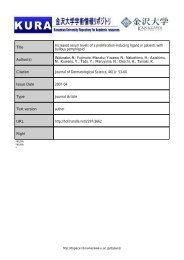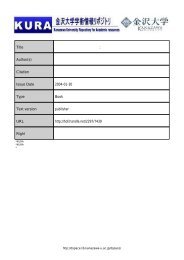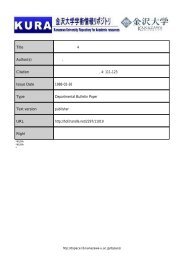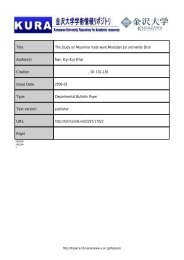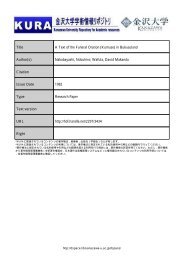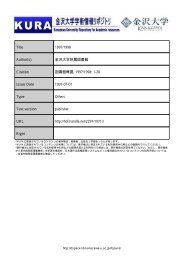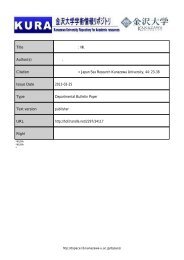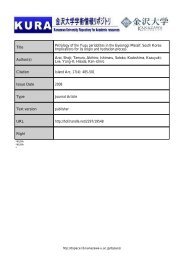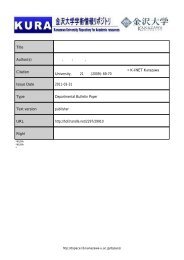Title A ski robot system for qualitative modelling of the carved turn ...
Title A ski robot system for qualitative modelling of the carved turn ...
Title A ski robot system for qualitative modelling of the carved turn ...
You also want an ePaper? Increase the reach of your titles
YUMPU automatically turns print PDFs into web optimized ePapers that Google loves.
1<br />
2<br />
3<br />
4<br />
5<br />
6<br />
7<br />
8<br />
9<br />
10<br />
11<br />
12<br />
13<br />
14<br />
15<br />
16<br />
17<br />
18<br />
19<br />
20<br />
21<br />
22<br />
23<br />
24<br />
25<br />
26<br />
27<br />
28<br />
29<br />
30<br />
31<br />
32<br />
33<br />
34<br />
A <strong>ski</strong> <strong>robot</strong> <strong>system</strong> <strong>for</strong> <strong>qualitative</strong> modeling <strong>of</strong> <strong>the</strong> <strong>carved</strong> <strong>turn</strong><br />
T. YONEYAMA, H. KAGAWA, M.UNEMOTO and T.IIZUKA<br />
Kanazawa University, Kakuma-machi, Kanazawa, Japan<br />
N.W. SCOTT<br />
University <strong>of</strong> Western Australia<br />
Correspondence<br />
Takeshi YONEYAMA<br />
Department <strong>of</strong> Human and Mechanical Engineering Systems,<br />
Faculty <strong>of</strong> Engineering<br />
Kanazawa University, Kakuma-machi, Kanazawa, 920-1192, Japan<br />
Tel & Fax ++81-76-234-4683<br />
E-mail: yoneyama@t.kanazawa-u.ac.jp<br />
Acknowledgement<br />
The authors wish to thank Mr. Takada, Miss Tsugawa, Mr. Igarashi and Mr. Urahata at<br />
Kanazawa University <strong>for</strong> <strong>the</strong>ir help in developing <strong>the</strong> <strong>robot</strong> and experimental methods. The<br />
authors also thank Dr.Takahashi <strong>for</strong> his assistance in developing <strong>the</strong> <strong>robot</strong>. This research was<br />
also supported by a grant from <strong>the</strong> Ministry <strong>of</strong> Science and Education and ano<strong>the</strong>r from <strong>the</strong><br />
Society <strong>of</strong> Mechatronics in Japan.
35<br />
36<br />
37<br />
38<br />
39<br />
40<br />
41<br />
42<br />
43<br />
44<br />
45<br />
46<br />
47<br />
48<br />
49<br />
50<br />
51<br />
52<br />
53<br />
54<br />
55<br />
56<br />
57<br />
58<br />
59<br />
60<br />
A <strong>ski</strong> <strong>robot</strong> <strong>system</strong> <strong>for</strong> <strong>qualitative</strong> modeling <strong>of</strong> <strong>the</strong> <strong>carved</strong> <strong>turn</strong><br />
Abstract<br />
A <strong>robot</strong> that simulates a human <strong>ski</strong>er per<strong>for</strong>ming <strong>carved</strong> <strong>turn</strong>s has been developed. Each<br />
leg had six degrees <strong>of</strong> freedom like those <strong>of</strong> human athletes. An on-board computer controlled<br />
<strong>the</strong> sequence <strong>of</strong> joint angles in an open-loop mode during <strong>ski</strong>ing on an artificial grass slope.<br />
The relations among joint motions, reacting <strong>for</strong>ces and <strong>turn</strong> trajectory were investigated<br />
by programming various motions <strong>of</strong> <strong>the</strong> <strong>robot</strong>. At first, <strong>the</strong> effect <strong>of</strong> basic joint motions such<br />
as abduction-adduction and flexion-extension <strong>of</strong> <strong>the</strong> hip, knee and ankle joints were tried.<br />
Then <strong>the</strong> sequence <strong>of</strong> a top athlete's joint motions, measured in a separate study, was applied<br />
to investigate its effect on <strong>the</strong> <strong>ski</strong> <strong>turn</strong>. The human-inspired program produced a more even<br />
<strong>for</strong>ce balance between <strong>the</strong> <strong>ski</strong>s and also a higher-quality <strong>turn</strong>.<br />
The requirements <strong>for</strong> a successful physical model <strong>of</strong> a human <strong>ski</strong>er are discussed.<br />
Introduction<br />
Athletes speak <strong>of</strong> <strong>the</strong> effectiveness <strong>of</strong> <strong>ski</strong> <strong>turn</strong>s, an elusive quality but one related to low<br />
energy loss, a good body posture at each stage in <strong>the</strong> <strong>turn</strong>, and a cleanly <strong>carved</strong> snow track.<br />
They desire to know how to <strong>turn</strong> well, meaning what is <strong>the</strong> correct sequence <strong>of</strong> leg and body<br />
angles during <strong>the</strong> <strong>turn</strong> to produce <strong>the</strong> smoo<strong>the</strong>st result. As a result <strong>the</strong>re have been many<br />
studies to elucidate <strong>ski</strong> athletes’ movements though various methods.<br />
One way is <strong>the</strong> direct measurement <strong>of</strong> <strong>the</strong> motion <strong>of</strong> <strong>the</strong> <strong>ski</strong>er in <strong>the</strong> actual <strong>turn</strong> on snow.<br />
Raschener et al (2000) measured joint angles and reacting <strong>for</strong>ces in order to investigate <strong>the</strong><br />
differences between carving <strong>turn</strong>s and traditional parallel <strong>turn</strong>s. Schiefermueller et al (2004))<br />
investigated <strong>the</strong> movement <strong>of</strong> <strong>the</strong> centre <strong>of</strong> gravity in <strong>the</strong> various <strong>turn</strong>ing phases. Yoneyama et<br />
al (2000) measured <strong>the</strong> joint angles motion and acting <strong>for</strong>ces to compare <strong>the</strong> <strong>turn</strong> motion<br />
using carving <strong>ski</strong>s and that using traditional <strong>ski</strong>s. Scott et al (2002) measured <strong>the</strong> joint motion
61<br />
62<br />
63<br />
64<br />
65<br />
66<br />
67<br />
68<br />
69<br />
70<br />
71<br />
72<br />
73<br />
74<br />
75<br />
76<br />
77<br />
78<br />
79<br />
80<br />
81<br />
82<br />
83<br />
84<br />
85<br />
angles in <strong>the</strong> measurement <strong>of</strong> top athlete’s <strong>turn</strong>. These studies are valuable but tend to<br />
simplify <strong>the</strong> leg joint kinematics by ignoring or not measuring some <strong>of</strong> <strong>the</strong> degrees <strong>of</strong> freedom.<br />
Also it is quite difficult to know <strong>the</strong> true bone angles because <strong>the</strong> bones are so well padded<br />
with dynamically bulging muscle, fat and so on. Measuring all <strong>the</strong> skeletal degrees <strong>of</strong> freedom<br />
during real snow <strong>ski</strong>ing is a challenging technical problem.<br />
A second way to explore <strong>the</strong> relationship between <strong>the</strong> joint angles and <strong>ski</strong> <strong>turn</strong> quality is<br />
through dynamic simulation. The most common purpose <strong>of</strong> such modeling seems to be to<br />
support <strong>the</strong> investigation <strong>of</strong> <strong>the</strong> <strong>ski</strong> per<strong>for</strong>mance, <strong>for</strong> example Casolo et al (2000), Nordt et al<br />
(1999) and Kawai et al (2004). Because many assumptions are necessary in <strong>the</strong> simulation <strong>of</strong><br />
<strong>the</strong> <strong>ski</strong> properties, snow properties and <strong>ski</strong>-snow contacting condition, <strong>the</strong>re are few attempts<br />
to investigate <strong>the</strong> effect <strong>of</strong> <strong>ski</strong>er’s motion on <strong>the</strong> <strong>turn</strong>. Glitsch (2000) made a computer<br />
simulation <strong>of</strong> alpine <strong>ski</strong>ing to investigate <strong>the</strong> effect <strong>of</strong> edging motion using a trapezoid<br />
mechanism model with rigid <strong>ski</strong>s. Takahashi et al (2000) proposed that <strong>ski</strong>ing may be<br />
understood from a simplified model with emphasis on <strong>the</strong> relationship between <strong>the</strong> centre <strong>of</strong><br />
mass and <strong>the</strong> <strong>ski</strong>s. Kagawa et al (2000) simulated <strong>the</strong> effective motion using a two<br />
dimensional analysis. Kawai et al (2004) developed a simulation <strong>system</strong> using a multi-body<br />
model fitted to a video image.<br />
A third way to explore <strong>the</strong> relationship between joint angles and <strong>turn</strong> quality is to develop a<br />
physical model: a <strong>ski</strong> <strong>robot</strong>. Shimizu et al (1987) developed several manually controlled <strong>ski</strong><br />
<strong>robot</strong>s. The <strong>robot</strong>s allowed exploration <strong>of</strong> <strong>the</strong> space <strong>of</strong> possible joint angle combinations and<br />
time sequence to produce effective <strong>ski</strong> <strong>turn</strong>s. The <strong>robot</strong> work showed <strong>the</strong> important <strong>of</strong> thigh<br />
rotation, which causes a change to both <strong>the</strong> <strong>ski</strong> edge angle and pointing direction. Hasegawa<br />
et al (2006) simulated <strong>the</strong> <strong>turn</strong> on <strong>the</strong> <strong>robot</strong> which per<strong>for</strong>ms thigh rotation. Zehetmayer (2000)<br />
demonstrated several <strong>ski</strong> <strong>robot</strong>s which could per<strong>for</strong>m <strong>turn</strong>s autonomously.<br />
The purpose <strong>of</strong> <strong>ski</strong> <strong>robot</strong>s is to allow experiments in which <strong>the</strong> actions <strong>of</strong> <strong>the</strong> <strong>ski</strong>er
86<br />
87<br />
88<br />
89<br />
90<br />
91<br />
92<br />
93<br />
94<br />
95<br />
96<br />
97<br />
98<br />
99<br />
100<br />
101<br />
102<br />
103<br />
104<br />
105<br />
106<br />
107<br />
108<br />
109<br />
110<br />
(meaning <strong>the</strong> <strong>robot</strong>) can be controlled repeatably, or can be measured in ways that are not<br />
feasible with human athletes. The perfect <strong>robot</strong> <strong>ski</strong>er would be like a human athlete in size,<br />
mass, mass distribution, power and degrees <strong>of</strong> freedom. Such a <strong>robot</strong> may arguably now be in<br />
reach <strong>of</strong> <strong>the</strong> best <strong>robot</strong> designers, but was beyond our capability. We will <strong>the</strong>re<strong>for</strong>e try to<br />
explain why we built what we did, and to show that it may have some value as a model.<br />
Why <strong>ski</strong> <strong>robot</strong> research?<br />
1. The sequence <strong>of</strong> joint angles with time can be programmed, and <strong>the</strong> trajectory and acting<br />
<strong>for</strong>ces can be recorded. The effect <strong>of</strong> a small change to <strong>the</strong> joint angle sequence can thus<br />
be brought out;<br />
2. As a refinement <strong>of</strong> (1), a sequence <strong>of</strong> joint angles recorded from a human athlete can be<br />
applied to <strong>the</strong> <strong>robot</strong>. Each human athlete has a slightly different personal style and <strong>the</strong>se<br />
can be examined in detail;<br />
3. Conversely if a superior sequence <strong>of</strong> joint angles is developed <strong>for</strong> <strong>the</strong> <strong>robot</strong>, human<br />
athletes could be asked to try to imitate it. The <strong>robot</strong> could <strong>the</strong>n function as a physical<br />
display or teaching <strong>system</strong>;<br />
4. Since a <strong>robot</strong> can <strong>ski</strong> very consistently, meaning with <strong>the</strong> same joint angle sequence each<br />
time, it is a useful experimental plat<strong>for</strong>m <strong>for</strong> studying <strong>the</strong> properties <strong>of</strong> <strong>the</strong> <strong>ski</strong>s.<br />
Modeling considerations<br />
A <strong>ski</strong> <strong>robot</strong> is meant to model a real <strong>ski</strong>er as closely as possible, so we must examine in detail<br />
what types <strong>of</strong> correspondence are most important.<br />
Force components during <strong>the</strong> <strong>turn</strong><br />
Fig. 1 shows a <strong>ski</strong>er with gross <strong>for</strong>ces. Analogous <strong>for</strong>ces appear in both <strong>the</strong> <strong>robot</strong>ic and human<br />
cases, even if <strong>the</strong> size or mass <strong>of</strong> <strong>the</strong> <strong>robot</strong> are very different from <strong>the</strong> human <strong>ski</strong>er. We also<br />
note that since <strong>the</strong> gravity <strong>for</strong>ce and centrifugal <strong>for</strong>ce are both proportional to mass, <strong>the</strong> ratio<br />
<strong>of</strong> gravity to centrifugal <strong>for</strong>ces depends only on <strong>the</strong> combination <strong>of</strong> slope angle, <strong>turn</strong>ing speed
111<br />
112<br />
113<br />
114<br />
115<br />
116<br />
117<br />
118<br />
119<br />
120<br />
121<br />
122<br />
123<br />
124<br />
125<br />
126<br />
127<br />
128<br />
129<br />
130<br />
131<br />
132<br />
133<br />
134<br />
135<br />
and <strong>turn</strong>ing radius. The reacting <strong>for</strong>ce from <strong>the</strong> slope surface is affected by <strong>the</strong> contacting<br />
angle between <strong>the</strong> <strong>ski</strong> and <strong>the</strong> slope surface, <strong>the</strong> mechanical properties <strong>of</strong> <strong>the</strong> slope surface<br />
and <strong>the</strong> friction coefficient between running surface and slope surface. Seen from this type <strong>of</strong><br />
gross-<strong>for</strong>ces perspective, <strong>the</strong> size, mass and mass distribution <strong>of</strong> <strong>the</strong> <strong>ski</strong>er are not so<br />
important.<br />
Mechanical properties <strong>of</strong> <strong>the</strong> <strong>ski</strong><br />
Although <strong>the</strong> <strong>turn</strong> radius <strong>of</strong> a <strong>ski</strong> depends on many parameters <strong>of</strong> <strong>the</strong> <strong>ski</strong> and contacting<br />
surface, in a pure <strong>carved</strong> <strong>turn</strong> <strong>the</strong> side-cut radius and elasticity <strong>of</strong> <strong>the</strong> <strong>ski</strong> are perhaps <strong>the</strong> most<br />
important parameters. In a <strong>ski</strong> <strong>robot</strong> experiment we have control over <strong>the</strong> slope angle and thus<br />
<strong>the</strong> velocities achieved. We can <strong>the</strong>n – in principle at least - choose <strong>the</strong> side cut radius and<br />
stiffness <strong>for</strong> <strong>the</strong> <strong>robot</strong> <strong>ski</strong>s so that <strong>the</strong> ratio <strong>of</strong> <strong>the</strong> gravity <strong>for</strong>ce to <strong>the</strong> centrifugal <strong>for</strong>ce is<br />
similar to <strong>the</strong> human case.<br />
Mechanical properties <strong>of</strong> <strong>the</strong> slope surface<br />
During <strong>ski</strong>ing on real snow, <strong>the</strong> surface is compressed and becomes harder immediately under<br />
<strong>the</strong> <strong>ski</strong>, and this harder surface produces <strong>the</strong> reaction <strong>for</strong>ce. Real snow is a tremendously<br />
complex material which can be different from day to day on <strong>the</strong> same slope. Since our<br />
purpose was to examine slight changes in <strong>the</strong> joint angle sequences, we had to eliminate<br />
sources <strong>of</strong> variability and thus used an artificial slope surface. We must <strong>the</strong>re<strong>for</strong>e examine<br />
whe<strong>the</strong>r an artificial surface can be a reasonable model <strong>for</strong> a real snow surface.<br />
Since we intend to model only pure <strong>carved</strong> <strong>turn</strong>s, <strong>the</strong> properties <strong>of</strong> <strong>the</strong> artificial surface in a<br />
“<strong>ski</strong>dding” mode were not considered important. Instead <strong>the</strong>re remains only <strong>the</strong> <strong>for</strong>ce <strong>of</strong><br />
sliding friction acting along <strong>the</strong> <strong>carved</strong> path <strong>of</strong> <strong>the</strong> <strong>ski</strong>. This <strong>for</strong>ce is mainly from <strong>the</strong> sliding<br />
friction <strong>of</strong> <strong>the</strong> <strong>ski</strong> but can also include a component <strong>of</strong> <strong>the</strong> snow-normal <strong>for</strong>ces in <strong>the</strong> velocity<br />
direction because <strong>of</strong> <strong>the</strong> elastic bent shape <strong>of</strong> <strong>the</strong> <strong>ski</strong>. The coefficient <strong>of</strong> sliding friction<br />
becomes <strong>the</strong> main measure <strong>of</strong> equivalence between <strong>the</strong> snow surface and artificial surface <strong>for</strong>
136<br />
137<br />
138<br />
139<br />
140<br />
141<br />
142<br />
143<br />
144<br />
145<br />
146<br />
147<br />
148<br />
149<br />
150<br />
151<br />
152<br />
153<br />
154<br />
155<br />
156<br />
157<br />
158<br />
159<br />
160<br />
our purposes, although <strong>the</strong> peak <strong>for</strong>ce that can be generated in <strong>the</strong> radial direction be<strong>for</strong>e<br />
slipping places an experimental limit on <strong>the</strong> centrifugal acceleration.<br />
The <strong>robot</strong> experiment <strong>system</strong><br />
Ski <strong>robot</strong><br />
Fig. 2 shows a schematic view <strong>of</strong> <strong>the</strong> <strong>robot</strong>, with dimensions shown in Fig.3. The length <strong>of</strong> <strong>the</strong><br />
leg and <strong>the</strong> width between <strong>the</strong> hip joints were 300mm and 160mm respectively. The ratio <strong>of</strong><br />
<strong>the</strong> hip joint width to <strong>the</strong> leg length was about 2, whereas human beings typically have a ratio<br />
<strong>of</strong> about 3. The mass <strong>of</strong> <strong>the</strong> upper body was 1.3kg and <strong>of</strong> <strong>the</strong> lower body 2.3kg, <strong>for</strong> a total<br />
mass <strong>of</strong> 3.6kg. The overall size and leg part lengths were chosen to be human-like in<br />
proportion within <strong>the</strong> constraints <strong>of</strong> <strong>the</strong> sizes <strong>of</strong> <strong>the</strong> joint servomotors. The centre <strong>of</strong> mass was<br />
224mm above <strong>the</strong> <strong>ski</strong> running surfaces. This means that <strong>the</strong> ratio <strong>of</strong> <strong>the</strong> height <strong>of</strong> <strong>the</strong> mass<br />
centre to <strong>the</strong> width between <strong>the</strong> two <strong>ski</strong>s was about 1.5, whereas in a human athlete it is<br />
typically 2.5 to 3. The centre <strong>of</strong> mass <strong>of</strong> our <strong>robot</strong> was thus relatively lower than <strong>for</strong> a human<br />
being. We tried a version <strong>of</strong> <strong>the</strong> <strong>robot</strong> with <strong>the</strong> “human” ratio but found it very difficult to<br />
control on <strong>the</strong> slope because <strong>the</strong> most common behaviour was to fall over. The lower ratio <strong>of</strong><br />
mass centre height to <strong>ski</strong> width <strong>of</strong> our <strong>robot</strong> was thus a design compromise and limitation <strong>of</strong><br />
this work. The non-human ratio affects <strong>the</strong> kinematics <strong>of</strong> <strong>the</strong> legs and centre <strong>of</strong> mass. For<br />
example if <strong>the</strong> <strong>robot</strong> per<strong>for</strong>ms a <strong>turn</strong> using hip joint abduction-adduction, <strong>the</strong> centre <strong>of</strong> mass<br />
<strong>of</strong> <strong>the</strong> <strong>robot</strong> will approach <strong>the</strong> slope more than <strong>for</strong> a human athlete, <strong>for</strong> <strong>the</strong> same leg angle.<br />
Similarly if <strong>the</strong> <strong>robot</strong> “squats” using a combination <strong>of</strong> flexion <strong>of</strong> <strong>the</strong> knee and hip, <strong>the</strong> centre<br />
<strong>of</strong> mass will fall more than <strong>for</strong> a human, <strong>for</strong> <strong>the</strong> same flexion angle.<br />
Each servomotor had a maximum torque <strong>of</strong> about 2Nm, whereas in a human athlete <strong>the</strong> hip<br />
joint and knee joint may produce more than 100Nm. The working torque in <strong>the</strong> <strong>robot</strong> was thus<br />
only about 2% <strong>of</strong> that in human athletes. However <strong>the</strong> mass <strong>of</strong> <strong>the</strong> <strong>robot</strong> was about 5% <strong>of</strong> a<br />
typical human. The ratio <strong>of</strong> working torque to weight <strong>for</strong>ce was thus smaller <strong>for</strong> <strong>the</strong> <strong>robot</strong>,
161<br />
162<br />
163<br />
164<br />
165<br />
166<br />
167<br />
168<br />
169<br />
170<br />
171<br />
172<br />
173<br />
174<br />
175<br />
176<br />
177<br />
178<br />
179<br />
180<br />
181<br />
182<br />
183<br />
184<br />
185<br />
relatively speaking. Our <strong>ski</strong> <strong>robot</strong> was not able to jump by hip and knee joint motions, as all<br />
<strong>ski</strong> athletes are well able to do, and thus could only <strong>ski</strong> in a fairly passive mode more like a<br />
recreational <strong>ski</strong>er than an athlete in competition.<br />
Skis used in <strong>the</strong> <strong>robot</strong> experiments<br />
It is typical <strong>for</strong> a human athlete to choose <strong>ski</strong>s about as long as <strong>the</strong>ir height. Applying this rule<br />
to our <strong>robot</strong>, we chose <strong>ski</strong> length 500mm. The boot centre was situated at 45% <strong>of</strong> <strong>the</strong> length<br />
from <strong>the</strong> tail. The side-cut radius <strong>of</strong> <strong>the</strong> <strong>ski</strong> in <strong>the</strong> <strong>robot</strong> experiment was 3m according to <strong>the</strong><br />
expected <strong>turn</strong> radius. The centre <strong>of</strong> <strong>the</strong> side curve was also at 45% <strong>of</strong> <strong>the</strong> length from <strong>the</strong> tail.<br />
The <strong>ski</strong>s were made <strong>of</strong> 8mm polycarbonate. The thickness was chosen so that with 10N<br />
applied to <strong>the</strong> boot centre, and an edge angle <strong>of</strong> 15°, <strong>the</strong> whole inside edge <strong>of</strong> <strong>the</strong> <strong>ski</strong> was in<br />
contact with <strong>the</strong> slope surface. Experiments showed that a thinner <strong>ski</strong> led to <strong>ski</strong>dding in <strong>the</strong><br />
later part <strong>of</strong> <strong>the</strong> <strong>turn</strong> cycle, but a thicker <strong>ski</strong> would touch <strong>the</strong> slope only at <strong>the</strong> top and tail<br />
points. Skis <strong>for</strong> human athletes have a gradient <strong>of</strong> stiffness along <strong>the</strong> length, whereas our <strong>robot</strong><br />
<strong>ski</strong>s were very plain.<br />
PTFE tape was applied to <strong>the</strong> <strong>ski</strong> running surface to reduce friction.<br />
Test slope<br />
The test slope was 11m long, 3m wide and had an inclination <strong>of</strong> 20°. The slope was<br />
covered with a carpet <strong>of</strong> plastic artificial grass.<br />
The coefficient <strong>of</strong> friction between <strong>the</strong> test slope and <strong>the</strong> PTFE-coated <strong>ski</strong>s was 0.24 <strong>for</strong><br />
straight <strong>ski</strong>ing and 0.26 <strong>for</strong> edging, whereas <strong>the</strong> coefficient <strong>of</strong> sliding friction <strong>for</strong> a <strong>ski</strong> on<br />
snow is about 0.1. If <strong>the</strong> <strong>ski</strong> <strong>robot</strong> were placed on <strong>the</strong> artificial grass with slope 15°, <strong>the</strong><br />
downhill sliding speed would remain about constant during <strong>the</strong> descent. To allow <strong>the</strong> <strong>robot</strong> to<br />
pick up speed be<strong>for</strong>e <strong>turn</strong>ing, <strong>the</strong> test slope angle was made 20°.<br />
When <strong>the</strong> edged <strong>ski</strong> was pressed against <strong>the</strong> slope surface during <strong>the</strong> <strong>turn</strong>s, <strong>the</strong> <strong>ski</strong> edge went<br />
into <strong>the</strong> artificial grass between <strong>the</strong> “stems”. The <strong>ski</strong> edge was thus supported by <strong>the</strong>
186<br />
187<br />
188<br />
189<br />
190<br />
191<br />
192<br />
193<br />
194<br />
195<br />
196<br />
197<br />
198<br />
199<br />
200<br />
201<br />
202<br />
203<br />
204<br />
205<br />
206<br />
207<br />
208<br />
209<br />
210<br />
elastically de<strong>for</strong>med grass and by <strong>the</strong> woven surface under <strong>the</strong> grass stems. This type <strong>of</strong><br />
support was less effective than that <strong>of</strong> real snow and radial sliding occurred quite readily.<br />
The artificial grass slope was thus a surface with higher tangential friction and lower radial<br />
support than real snow, a limitation <strong>of</strong> this work.<br />
Instrumentation<br />
The experimental plan was to measure <strong>the</strong> trajectory <strong>of</strong> <strong>the</strong> <strong>robot</strong> using a video camera, and to<br />
measure front and rear <strong>ski</strong>-normal “boot” <strong>for</strong>ces.<br />
The load cell arrangement may be seen in Fig. 5(a). The custom-made load cells were based<br />
on a parallel-plate structure and strain gauges, and were sensitive mainly to <strong>for</strong>ces normal to<br />
<strong>the</strong> <strong>ski</strong>. The rear connection between <strong>the</strong> load cell and <strong>ski</strong> had a sliding joint to permit <strong>the</strong><br />
dimensional change associated with <strong>ski</strong> bending.<br />
A distance and speed-measuring device was mounted at <strong>the</strong> rear <strong>of</strong> each <strong>ski</strong> as shown in<br />
Fig. 5(b). These consisted <strong>of</strong> a pair <strong>of</strong> light plastic too<strong>the</strong>d wheels on a common shaft. An<br />
optical encoder in <strong>the</strong> assembly measured <strong>the</strong> rotation <strong>of</strong> <strong>the</strong> wheels, which <strong>turn</strong>ed with low<br />
friction. This sensor was used to help compute <strong>the</strong> <strong>ski</strong> trajectory and also to detect <strong>the</strong> start<br />
instant in each experiment, when <strong>the</strong> <strong>robot</strong> velocity had reached a programmed threshold.<br />
A video camera placed at <strong>the</strong> bottom <strong>of</strong> <strong>the</strong> slope captured each <strong>ski</strong>ing event. To assist <strong>the</strong><br />
analysis <strong>of</strong> <strong>the</strong> video frames, an electric lamp was set at <strong>the</strong> front and rear end <strong>of</strong> each <strong>ski</strong>.<br />
These were <strong>turn</strong>ed on under s<strong>of</strong>tware control at <strong>the</strong> start instant during <strong>the</strong> <strong>ski</strong> motion.<br />
Operating <strong>system</strong><br />
The control <strong>system</strong> is illustrated in Fig. 6. A computer and batteries were installed in <strong>the</strong><br />
upper body. The computer was an "Eyebot" developed by Pr<strong>of</strong>. Braunl <strong>of</strong> The University <strong>of</strong><br />
Western Australia. The Eyebot controlled <strong>the</strong> servomotor angles. An AVR coprocessor was<br />
used <strong>for</strong> data collection from <strong>the</strong> load cells and wheel encoders, and was connected by a<br />
parallel cable to <strong>the</strong> Eyebot. It was possible to capture a time history <strong>of</strong> <strong>for</strong>ce and position
211<br />
212<br />
213<br />
214<br />
215<br />
216<br />
217<br />
218<br />
219<br />
220<br />
221<br />
222<br />
223<br />
224<br />
225<br />
226<br />
227<br />
228<br />
229<br />
230<br />
231<br />
232<br />
233<br />
234<br />
235<br />
change in <strong>the</strong> memory <strong>of</strong> <strong>the</strong> Eyebot. The batteries were <strong>of</strong> <strong>the</strong> lithium-ion type and <strong>the</strong>re was<br />
a separate battery <strong>for</strong> logic and <strong>for</strong> servomotors<br />
Motion program<br />
The motion programs were open-loop histories in which each joint angle was<br />
programmed as a sine function with a certain amplitude and phase shift. A typical experiment<br />
trajectory and <strong>robot</strong> posture are shown in Fig. 7. The program parameters were chosen so that<br />
<strong>the</strong> <strong>robot</strong> made at least two <strong>turn</strong>s after an initial straight descent. When <strong>the</strong> <strong>robot</strong> reached<br />
1 m/s in <strong>the</strong> descent, it always <strong>turn</strong>ed to <strong>the</strong> left at first, <strong>the</strong>n to <strong>the</strong> right and finally to <strong>the</strong> left<br />
again. The first left <strong>turn</strong> was thus a half-<strong>turn</strong> but one full cycle followed. Owing to <strong>the</strong> limit <strong>of</strong><br />
<strong>the</strong> slope length, <strong>the</strong> main region <strong>of</strong> interest was <strong>the</strong> first <strong>turn</strong> change from <strong>the</strong> left <strong>turn</strong> to <strong>the</strong><br />
right <strong>turn</strong> and <strong>the</strong> following first half and second half <strong>of</strong> <strong>the</strong> right <strong>turn</strong>. In each motion<br />
program it was found that <strong>the</strong> range <strong>of</strong> parameters <strong>for</strong> a successful <strong>turn</strong> was quite narrow. A<br />
slight change in <strong>the</strong> amplitude or phase would mean ei<strong>the</strong>r stable <strong>turn</strong> behaviour or <strong>the</strong> more<br />
usual falling and crashing behaviour.<br />
Experiments<br />
As a basic examination <strong>of</strong> <strong>the</strong> effect <strong>of</strong> joint motion, simple motion programs were created to<br />
activate only <strong>the</strong> abduction-adduction motion and only <strong>the</strong> flexion-extension motion.<br />
Effect <strong>of</strong> abduction-adduction<br />
Fig. 8 shows results from an experiment with abduction-adduction motion only. The joint<br />
angle history, resultant <strong>for</strong>ces on both <strong>ski</strong>s and sliding velocities are shown in <strong>the</strong> left side.<br />
The fluctuation in <strong>the</strong> <strong>for</strong>ces may be due to vibration <strong>of</strong> <strong>the</strong> <strong>robot</strong> body. The <strong>turn</strong> trajectory<br />
inferred from <strong>the</strong> video footage is shown in <strong>the</strong> middle. The differences in <strong>the</strong> apparent <strong>ski</strong><br />
lengths and some anomalies in <strong>the</strong> <strong>ski</strong> directions may be caused by errors in <strong>the</strong> <strong>ski</strong> lamp<br />
positions identified in <strong>the</strong> video frames. If we compare <strong>the</strong> joint angle change diagram and <strong>the</strong><br />
<strong>turn</strong> trajectory trace, it will be seen that <strong>the</strong> time <strong>of</strong> <strong>the</strong> <strong>turn</strong> direction change coincided with
236<br />
237<br />
238<br />
239<br />
240<br />
241<br />
242<br />
243<br />
244<br />
245<br />
246<br />
247<br />
248<br />
249<br />
250<br />
251<br />
252<br />
253<br />
254<br />
255<br />
256<br />
257<br />
258<br />
259<br />
260<br />
<strong>the</strong> time that <strong>the</strong> joint angle crossed zero. This means that <strong>the</strong> <strong>ski</strong> direction change was<br />
determined mainly by <strong>the</strong> edge angle.<br />
Comparing <strong>the</strong> <strong>for</strong>ce on <strong>the</strong> left and right foot with <strong>the</strong> joint angle history and <strong>turn</strong><br />
trajectory, it is noticed that at first, when abduction to <strong>the</strong> right started, <strong>the</strong> right load increased.<br />
Then, when abduction was reduced, <strong>the</strong> left load increased. In <strong>the</strong> next half right <strong>turn</strong>, <strong>the</strong><br />
right load was larger than <strong>the</strong> left load. This means that during <strong>the</strong> first half <strong>turn</strong>, <strong>the</strong> inside<br />
load was larger than <strong>the</strong> outside load. This may be due to <strong>the</strong> low <strong>ski</strong>ing velocity, which meant<br />
that <strong>the</strong> centrifugal <strong>for</strong>ces were small and <strong>the</strong> <strong>robot</strong> was essentially in a static posture on <strong>the</strong><br />
slope. This caused an increase in <strong>the</strong> <strong>for</strong>ce on <strong>the</strong> foot which was situated on <strong>the</strong> down-slope<br />
side. In <strong>the</strong> second half <strong>of</strong> <strong>the</strong> <strong>turn</strong>, both loads were nearly equal. From our o<strong>the</strong>r work with<br />
<strong>the</strong> measurement <strong>of</strong> human <strong>ski</strong>ers (Scott 2002), we know that a human <strong>ski</strong>er adopting an<br />
abduction-adduction pose will tend to have a higher <strong>for</strong>ce on <strong>the</strong> outside leg in nearly every<br />
case, even in <strong>the</strong> first part <strong>of</strong> a <strong>turn</strong>.<br />
Effect <strong>of</strong> flexion-extension <strong>of</strong> <strong>the</strong> knee joint<br />
A motion program was made such that <strong>the</strong> <strong>ski</strong> was controlled by a combination <strong>of</strong> flexion<br />
<strong>of</strong> <strong>the</strong> hip, knee and ankle joints as shown in Fig. 9. The inside <strong>ski</strong> was effectively lifted but<br />
remained parallel to <strong>the</strong> outside <strong>ski</strong>. The <strong>robot</strong>'s body was thus inclined towards <strong>the</strong> inside <strong>of</strong><br />
<strong>the</strong> curve as expected. It may be considered that <strong>the</strong> change <strong>of</strong> <strong>the</strong> ankle joint angle is small in<br />
<strong>the</strong> case <strong>of</strong> human <strong>ski</strong> athlete because <strong>the</strong> foot is fixed in <strong>the</strong> boot. But it is necessary to keep<br />
<strong>the</strong> inside <strong>ski</strong> parallel to <strong>the</strong> outside <strong>ski</strong> without moving much <strong>for</strong>ward <strong>of</strong> <strong>the</strong> outside <strong>ski</strong>. The<br />
edge angle can be found from a simple geometric consideration <strong>of</strong> <strong>the</strong> separation <strong>of</strong> <strong>the</strong> <strong>ski</strong>s<br />
and <strong>the</strong> amount <strong>of</strong> lift. The measured <strong>for</strong>ces, velocity, <strong>turn</strong> trajectory and <strong>robot</strong> posture are<br />
shown in Fig. 10. The <strong>turn</strong> change occurred at <strong>the</strong> same time as <strong>the</strong> change from flexion to<br />
extension. The inside foot <strong>for</strong>ce was again larger than <strong>the</strong> outside foot <strong>for</strong>ce during <strong>the</strong> first<br />
half <strong>of</strong> each <strong>turn</strong>. The <strong>ski</strong>ing velocity increased gradually during <strong>the</strong> experiment. These results
261<br />
262<br />
263<br />
264<br />
265<br />
266<br />
267<br />
268<br />
269<br />
270<br />
271<br />
272<br />
273<br />
274<br />
275<br />
276<br />
277<br />
278<br />
279<br />
280<br />
281<br />
282<br />
283<br />
284<br />
were similar to those <strong>for</strong> <strong>the</strong> previous experiment (abduction-adduction only). The <strong>turn</strong><br />
trajectory was also similar although in this latter experiment <strong>the</strong>re was more radial <strong>ski</strong>dding.<br />
The successful range <strong>of</strong> <strong>the</strong> motion angles <strong>for</strong> this flexion-extension experiment was found to<br />
be narrow. This indicates that given our choices <strong>of</strong> velocity, slope angle, side-cut radius and<br />
<strong>ski</strong> stiffness, <strong>the</strong> space <strong>of</strong> <strong>the</strong> possible edging angles was limited by <strong>the</strong> dimensions and mass<br />
<strong>of</strong> <strong>the</strong> <strong>ski</strong>ing <strong>robot</strong>.<br />
From <strong>the</strong>se experiments, we found that both abduction-adduction and <strong>the</strong> <strong>ski</strong>-lifting approach<br />
were useful motions <strong>for</strong> effective <strong>ski</strong> control and <strong>turn</strong>ing. In both motions, <strong>the</strong> <strong>robot</strong> centre <strong>of</strong><br />
mass crossed over <strong>the</strong> <strong>ski</strong>s perpendicular to <strong>the</strong> <strong>ski</strong>ing direction during <strong>the</strong> <strong>turn</strong> change.<br />
Emulation <strong>of</strong> <strong>the</strong> motion <strong>of</strong> a top athlete<br />
Measurements <strong>of</strong> a top athlete, Mr Hirasawa, a <strong>for</strong>mer world cup racer, revealed that he<br />
<strong>turn</strong>ed his waist to face inside <strong>the</strong> <strong>turn</strong> arc (Scott et al 2004). A motion plan <strong>for</strong> <strong>the</strong> <strong>robot</strong> to<br />
simulate this situation was programmed as shown in Fig. 11. The main motion was<br />
flexion-extension with a small amount <strong>of</strong> abduction-adduction. Thigh rotation and lower leg<br />
rotation were added to face <strong>the</strong> waist inside <strong>the</strong> trajectory tangent as shown in <strong>the</strong> top view on<br />
<strong>the</strong> upper right side <strong>of</strong> <strong>the</strong> figure. This combination <strong>of</strong> motions moved <strong>the</strong> centre <strong>of</strong> mass<br />
slightly <strong>for</strong>ward and made <strong>the</strong> waist <strong>turn</strong> inwards. The resulting trajectory is shown in <strong>the</strong><br />
lower part <strong>of</strong> Fig. 12. If <strong>the</strong> <strong>for</strong>ce traces are compared with those from <strong>the</strong> previous<br />
experiment (no thigh or lower leg rotation), <strong>the</strong> <strong>for</strong>ce was more evenly shared between <strong>the</strong><br />
feet. The <strong>turn</strong> also became more stable and <strong>the</strong> change <strong>of</strong> <strong>the</strong> <strong>ski</strong>ing direction in <strong>the</strong> first half<br />
<strong>of</strong> each <strong>turn</strong> was faster. We think this may be due to <strong>the</strong> motion <strong>of</strong> <strong>the</strong> centre <strong>of</strong> <strong>the</strong> mass <strong>of</strong><br />
<strong>the</strong> <strong>robot</strong>. The <strong>ski</strong> posture with <strong>the</strong> waist facing inward may be a valuable approach <strong>for</strong><br />
athletes who wish to have a smaller radius in <strong>the</strong> first half <strong>of</strong> each <strong>turn</strong>.
285<br />
286<br />
287<br />
288<br />
289<br />
290<br />
291<br />
292<br />
293<br />
294<br />
295<br />
296<br />
297<br />
298<br />
299<br />
300<br />
301<br />
302<br />
303<br />
304<br />
305<br />
306<br />
307<br />
308<br />
309<br />
Discussion<br />
Comparison with human <strong>ski</strong>ing<br />
When a human athlete makes a long <strong>turn</strong>, <strong>the</strong> load on <strong>the</strong> outside <strong>ski</strong> is usually about<br />
double that on <strong>the</strong> inside <strong>ski</strong> during <strong>the</strong> whole <strong>turn</strong> cycle, including <strong>the</strong> first half (Scott et al,<br />
2004). That work also showed that both <strong>the</strong> inside and outside leg <strong>for</strong>ces reduce to nearly zero<br />
at <strong>the</strong> <strong>turn</strong> change. Human <strong>ski</strong>ing is thus very much governed by dynamic <strong>for</strong>ces. However, in<br />
our <strong>robot</strong> experiments, <strong>the</strong> <strong>ski</strong>ing velocity in <strong>the</strong> right <strong>turn</strong> increased from 2 to 3 m/s with a<br />
<strong>turn</strong> radius <strong>of</strong> about 7m. The centripetal acceleration was only about 0.6 to 1.3m/s 2 . However<br />
in an example <strong>of</strong> top athlete’s long <strong>turn</strong> <strong>the</strong> speed is about 16m/s and <strong>the</strong> radius perhaps 30m.<br />
The centripetal acceleration in <strong>the</strong> human case is thus about 8m/s 2 , similar in magnitude to<br />
gravity. Compared to <strong>the</strong> <strong>robot</strong>, <strong>the</strong> posture <strong>of</strong> <strong>the</strong> human athlete is much more steeply<br />
inclined towards <strong>the</strong> centre <strong>of</strong> curvature. In order to achieve <strong>the</strong> same centripetal acceleration<br />
in <strong>the</strong> <strong>robot</strong> experiment as in <strong>the</strong> human one, <strong>the</strong> <strong>turn</strong> radius must be reduced or <strong>the</strong> velocity<br />
must be increased. But when such approaches were tried in <strong>the</strong> experiment, <strong>ski</strong>dding <strong>of</strong> <strong>the</strong><br />
<strong>ski</strong> has been observed. As observed above, (1) our artificial running surface was un<strong>for</strong>tunately<br />
ra<strong>the</strong>r different from snow <strong>for</strong> <strong>the</strong> case <strong>of</strong> radial (outward) <strong>for</strong>ces, and (2) <strong>the</strong> <strong>robot</strong> has a<br />
much lower power-to-weight ratio than a human being.<br />
Significance <strong>of</strong> <strong>the</strong> <strong>robot</strong> experiment<br />
The <strong>robot</strong> is still in development and much remains to be done. However, we think it is<br />
still able to tell us something about <strong>the</strong> real effect <strong>of</strong> each <strong>of</strong> <strong>the</strong> joint motions and o<strong>the</strong>r<br />
factors <strong>of</strong> <strong>the</strong> <strong>ski</strong> <strong>turn</strong>, at least in a <strong>qualitative</strong> sense.<br />
The <strong>robot</strong> has allowed us to separate <strong>the</strong> effect <strong>of</strong> each <strong>of</strong> <strong>the</strong> joint motions.<br />
Abduction-adduction and flexion-extension motions have been found to be effective because<br />
<strong>the</strong>y directly change <strong>the</strong> edge angle <strong>of</strong> <strong>the</strong> <strong>ski</strong>. By emulating <strong>the</strong> detailed joint angles <strong>of</strong> a<br />
<strong>ski</strong>lled athlete, we were able to fur<strong>the</strong>r improve <strong>the</strong> <strong>ski</strong>ing per<strong>for</strong>mance <strong>of</strong> <strong>the</strong> <strong>robot</strong>. A series
310<br />
311<br />
312<br />
313<br />
314<br />
315<br />
316<br />
317<br />
318<br />
319<br />
320<br />
321<br />
322<br />
323<br />
324<br />
325<br />
326<br />
327<br />
328<br />
329<br />
330<br />
331<br />
332<br />
333<br />
<strong>of</strong> leg angle changes to point <strong>the</strong> waist inward during <strong>the</strong> <strong>turn</strong>, modelled on <strong>the</strong> human expert,<br />
was found to be particularly effective. Load sharing between <strong>the</strong> <strong>ski</strong>s was improved and <strong>the</strong><br />
downhill <strong>for</strong>ce increased in <strong>the</strong> first half <strong>of</strong> each <strong>turn</strong>. We expect to extend this approach in<br />
future by applying observations from <strong>the</strong> measurement <strong>of</strong> more athletes.<br />
Conclusions<br />
Some steps to develop a <strong>robot</strong> experiment <strong>system</strong> to investigate <strong>the</strong> effect <strong>of</strong> joint motions on<br />
<strong>the</strong> <strong>ski</strong> <strong>turn</strong> have been achieved. Requirements <strong>for</strong> physical modeling using a <strong>ski</strong> <strong>robot</strong> have<br />
been investigated. A <strong>robot</strong> that had degrees <strong>of</strong> freedom in <strong>the</strong> legs like those <strong>of</strong> a human <strong>ski</strong>er<br />
was developed to investigate <strong>the</strong> relations among joint motions, acting <strong>for</strong>ces and <strong>turn</strong><br />
trajectory. The <strong>robot</strong> had <strong>for</strong>ce sensors between each ‘foot’ and <strong>ski</strong>, and an odometer at <strong>the</strong><br />
rear <strong>of</strong> each <strong>ski</strong>. The trajectory was measured by a video camera mounted at <strong>the</strong> base <strong>of</strong> <strong>the</strong><br />
slope. The servomotors in <strong>the</strong> <strong>robot</strong> were driven in an open-loop mode according to a chosen<br />
pattern <strong>of</strong> sinusoidal angles. From experiments we found that <strong>ski</strong>ing could be achieved<br />
provided <strong>the</strong> joint angle history was carefully tuned to prevent falling over. Also:<br />
1. A simple sinusoidal angle change in <strong>the</strong> abduction-adduction motion and also in <strong>the</strong><br />
flexion-extension motion could be tuned to produce an effective <strong>turn</strong> change followed by<br />
a <strong>carved</strong> <strong>turn</strong> arc.<br />
2. A motion program developed from measured <strong>ski</strong> athlete data, and having<br />
flexion-extension, abduction-adduction combined with thigh rotation and lower leg<br />
rotation produced better foot <strong>for</strong>ce balance and a steady smooth <strong>turn</strong>.<br />
The <strong>ski</strong> <strong>robot</strong> was quite different from a human being, limiting its usefulness as a model. The<br />
main issues were <strong>the</strong> non-human ratio <strong>of</strong> mass centre height to <strong>ski</strong> separation distance, <strong>the</strong><br />
ratio <strong>of</strong> <strong>the</strong> power <strong>of</strong> <strong>the</strong> motors to <strong>the</strong> mass, and <strong>the</strong> frictional properties <strong>of</strong> <strong>the</strong> non-snow<br />
slope surface.
334<br />
335<br />
336<br />
337<br />
338<br />
339<br />
340<br />
341<br />
342<br />
343<br />
344<br />
345<br />
346<br />
347<br />
348<br />
349<br />
350<br />
351<br />
352<br />
353<br />
354<br />
355<br />
356<br />
357<br />
358<br />
References<br />
Casolo, F. and Lorenzi,V. (2000) Relevance <strong>of</strong> <strong>ski</strong> mechanical and geometrical properties in<br />
carving technique: a dynamic simulation, Proc. <strong>of</strong> <strong>the</strong> 2 nd Int. Congress on Skiing and<br />
Science. pp.165-179.<br />
Glitsch, U. (2000) Computer simulation <strong>of</strong> alpine <strong>ski</strong>ing, Proc. <strong>of</strong> <strong>the</strong> 2 nd Int. Congress on<br />
Skiing and Science, pp.141-154.<br />
Hasegawa, K. (2004) Introduction to Ski Sciences: Mechanics <strong>of</strong> <strong>ski</strong>ing, Japan Society <strong>of</strong> Ski<br />
Sciences, Vol.14, No.1, pp35-56 (in Japanese).<br />
Hasegawa, K.(2006) Pflug Bogen and Carving Turn: Comparison <strong>of</strong> dynamics underlying<br />
<strong>turn</strong> techniques using <strong>ski</strong>dding and carving, Japan Society <strong>of</strong> Ski and Sciences, Vol.16,<br />
No.1, pp.51-60 (in Japanese).<br />
Kagawa, H. and Yoneyama, T. (2000) Effective Action <strong>of</strong> Skier’s Center <strong>of</strong> Mass in Skiing,<br />
Proc. <strong>of</strong> <strong>the</strong> 2 nd Int. Congress on Skiing and Science.<br />
Kawai, S., Otani, H. and Sakata, T. (2004) Ski control model <strong>for</strong> parallel <strong>turn</strong> using multibody<br />
<strong>system</strong>, JSME International Journal Series C, Vol.47, No.4, pp.1095-1100.<br />
Kodera, T. and Hasegawa, K. (1998) Dynamics <strong>of</strong> parallel <strong>turn</strong>, Journal <strong>of</strong> JSME (C), 64, 623,<br />
pp. 65-71(in Japanese).<br />
Nordt, A., Springer, G. and Kollar, L. (1999) Simulation <strong>of</strong> a <strong>turn</strong> on alpine <strong>ski</strong>s, Sports<br />
Engineering, 2, pp. 181-199.<br />
Raschener, C., Schiefermueller, C., Zallinger, G. H<strong>of</strong>er, E., Mueller, E. and Brunner, F. (2000)<br />
Carving <strong>turn</strong>s versus traditional parallel <strong>turn</strong>s-a comparative biomechanical analysis, Proc.<br />
<strong>of</strong> <strong>the</strong> 2 nd Int. Congress on Skiing and Science.<br />
Shiefermueller, C., Lindinger, S. and Mueller, E. (2004) The <strong>ski</strong>er’s centre <strong>of</strong> gravity as a<br />
reference point in movement analyses <strong>for</strong> different designated <strong>system</strong>s, Proc. <strong>of</strong> <strong>the</strong> 3 rd Int.<br />
Congress on Skiing and Science.
359<br />
360<br />
361<br />
362<br />
363<br />
364<br />
365<br />
366<br />
367<br />
368<br />
369<br />
370<br />
371<br />
372<br />
373<br />
374<br />
375<br />
376<br />
377<br />
378<br />
Scott, N.W., Yoneyama, T., Kagawa, H. and Takahashi, M.,(2002) Measurement <strong>of</strong> joint<br />
th<br />
motion and acting <strong>for</strong>ces on a top athlete <strong>ski</strong>ing, Proc. <strong>of</strong> <strong>the</strong> 5 Int. Conf. on Engineering<br />
<strong>of</strong> Sport, pp. 494-502.<br />
Shimizu, S. (1987) Science <strong>of</strong> <strong>ski</strong> (in Japanese), Kobunsha Press.<br />
Takahashi, M. and Yoneyama, T. (2000) The Acceleration <strong>of</strong> Ski <strong>turn</strong> by Skating Action, Proc.<br />
<strong>of</strong> <strong>the</strong> 2 nd Int. Congress on Skiing and Science.<br />
Vodickova, S., Lufinka, A. and Zubek, T. (2004), The dynamographic and kinematographic<br />
method application <strong>for</strong> a short carving <strong>turn</strong>, Proc. <strong>of</strong> <strong>the</strong> 3 rd Int. Congress on Skiing and<br />
Science.<br />
Yoneyama, T., Kagawa, H., Okamoto, A. and Sawada, M. (2000) Joint Motion and Reacting<br />
Forces in <strong>the</strong> Carving Ski Turn compared with <strong>the</strong> Conventional Ski Turn, Sports<br />
Engineering, Vol.3 No.3, pp.161-176.<br />
Yoneyama, T. and Kagawa H. (1998), Ski <strong>robot</strong> <strong>turn</strong> and <strong>the</strong> reacting <strong>for</strong>ce, Journal <strong>of</strong> JSME<br />
(C), 64, 623, pp.2369-2374 (in Japanese)<br />
Yoneyama, T., Kagawa, H. and Funahashi, N. (2002) Study on <strong>the</strong> effective <strong>turn</strong> motion using<br />
a <strong>ski</strong> <strong>robot</strong>, The Engineering <strong>of</strong> Sport 4, pp. 463-469.<br />
Yoneyama, T, Kagawa, H. and Scott, N. (2004) Ski <strong>robot</strong> <strong>system</strong> <strong>for</strong> <strong>the</strong> study <strong>of</strong> effective<br />
<strong>turn</strong> motions, The Engineering <strong>of</strong> Sport 5, pp.478-483.<br />
Zehelmayer, H.(2000) Fahrversuche mit Skimodellen In, Spectrum der Sportwissenschaften<br />
1,39-52.
379<br />
380<br />
381<br />
382<br />
383<br />
384<br />
385<br />
386<br />
387<br />
388<br />
389<br />
390<br />
Fig. 1 Force components parallel to <strong>the</strong> snow surface during a <strong>ski</strong> <strong>turn</strong><br />
Fig. 2 Schematic view <strong>of</strong> <strong>the</strong> <strong>ski</strong> <strong>robot</strong><br />
Fig. 3 Dimensions <strong>of</strong> <strong>the</strong> <strong>ski</strong> <strong>robot</strong><br />
Fig. 4 Joint motions <strong>of</strong> <strong>the</strong> <strong>ski</strong> <strong>robot</strong><br />
Fig. 5 Load cells, a speed meter installed on <strong>the</strong> <strong>robot</strong><br />
Fig. 6 Operation <strong>system</strong> <strong>of</strong> <strong>the</strong> <strong>ski</strong> <strong>robot</strong><br />
Fig. 7 Expected <strong>turn</strong> trajectory on <strong>the</strong> slope<br />
Fig. 8 Typical <strong>ski</strong> <strong>robot</strong> <strong>turn</strong> by abduction-adduction<br />
Fig. 9 Joint angle diagrams <strong>for</strong> flexion-extension motion<br />
Fig. 10 Typical <strong>ski</strong> <strong>robot</strong> <strong>turn</strong> by flexion-extension motion<br />
Fig. 11 Joint motion diagrams inspired by a top athlete’s motion<br />
Fig. 12 Typical <strong>ski</strong> <strong>robot</strong> <strong>turn</strong> using <strong>the</strong> program inspired by a top athlete’s motion
Gravity <strong>for</strong>ce in <strong>the</strong><br />
falling direction<br />
mg<br />
⋅sin<br />
α<br />
Centrifugal<br />
<strong>for</strong>ce 2<br />
m<br />
Reacting <strong>for</strong>ce from<br />
R<br />
<strong>the</strong> slope surface in<br />
<strong>the</strong> slope plane<br />
Gravity <strong>for</strong>ce in <strong>the</strong><br />
falling direction<br />
mg<br />
⋅sin<br />
α<br />
Reacting g <strong>for</strong>ce from<br />
<strong>the</strong> slope surface in<br />
<strong>the</strong> slope plane<br />
R<br />
Turning velocity v<br />
v<br />
Centrifugal<br />
<strong>for</strong>ce<br />
α Slope angle<br />
α<br />
m<br />
v 2<br />
v<br />
R
Computer board<br />
Battery<br />
6 servo motors<br />
in each leg<br />
Speed meter<br />
Load cell<br />
Compass
Weight<br />
3.6kg<br />
Radius 3m
Abduction<br />
andd<br />
Adduction<br />
Knee<br />
flexion<br />
(a) Abduction and adduction (b) Flexion-extension<br />
Hip joint<br />
flexion<br />
Thigh<br />
rotation<br />
Ankle<br />
fl flexion i Lower leg<br />
rotation<br />
()Thih (c) Thigh rotation, tti llower<br />
leg rotation
Load cell<br />
Strain gauge<br />
Front load<br />
Pin joint<br />
(a) Load cell<br />
(b) Speed meter<br />
Ski<br />
Back load<br />
Sliding pin joint<br />
Wheel<br />
Encoder
Eyebot<br />
AVR<br />
A/D<br />
Pulse<br />
count<br />
Servomotor<br />
12pieces p<br />
Strain gauge Load cell<br />
amplifier p 4pieces p<br />
Amplifier<br />
Speed sensor<br />
Lamp<br />
Magnetic field<br />
sensor
Looad<br />
(N)<br />
Velocity (m/ /s)<br />
30<br />
20<br />
10<br />
0<br />
4<br />
3<br />
2<br />
1<br />
0<br />
Left<br />
Right<br />
0 1<br />
Time (s)<br />
2 3<br />
(b) Applied <strong>for</strong>ce on <strong>the</strong> <strong>ski</strong><br />
0 1 2 3<br />
Time (s)<br />
(c) Velocity<br />
Displlacement<br />
X (m)<br />
0<br />
1<br />
2<br />
3<br />
4<br />
5<br />
6<br />
7<br />
8<br />
9<br />
10<br />
0(s)<br />
0.53(s)<br />
1.07(s)<br />
1.60(s)<br />
2.13(s)<br />
2.67(s)<br />
0 1 2<br />
Displacement Y (m)<br />
(d) Turn trajectory<br />
Turn change<br />
22.93s 93<br />
0s<br />
2.40s<br />
11.07s 07<br />
(e) Postures <strong>of</strong> <strong>the</strong> <strong>robot</strong><br />
during <strong>the</strong> <strong>turn</strong><br />
1.87s
Anglee<br />
(deg)<br />
Angle (degg)<br />
Angle A (deg)<br />
30<br />
20<br />
10<br />
0<br />
-10<br />
-20<br />
-30<br />
Left<br />
Right<br />
0 1 2 3<br />
Time (s)<br />
Hip joint flexion<br />
Anglee<br />
(deg)<br />
Angle (degg)<br />
30<br />
20<br />
10<br />
0<br />
-10<br />
-20<br />
-30<br />
Angle A (deg)<br />
Left<br />
Right<br />
0 1 2 3<br />
Ti Time (s) ( )<br />
Abduction-adduction<br />
30<br />
20<br />
-10<br />
-20<br />
-30<br />
Left<br />
30<br />
20 Left<br />
0<br />
20<br />
10<br />
30<br />
e<br />
Right<br />
20<br />
10<br />
0<br />
-10<br />
-20<br />
-30<br />
Left<br />
Right<br />
0 1<br />
Time (s)<br />
2 3<br />
0 1<br />
Time (s)<br />
2 3<br />
Knee flexion<br />
Thigh rotation<br />
30<br />
30<br />
20<br />
10<br />
Left 20<br />
10<br />
Left<br />
0<br />
0<br />
-10<br />
-20<br />
-30<br />
Right<br />
-10<br />
-20 20<br />
-30<br />
Right<br />
0 1<br />
Time (s)<br />
2 3 0 1 2<br />
Time (s)<br />
3<br />
Ankle flexion<br />
LLower leg l rotation t ti<br />
(a) Motion diagram<br />
Ski direction<br />
Waist<br />
direction
Loaad(N)<br />
Velocity(m/s)<br />
V<br />
30<br />
20<br />
10<br />
0<br />
Left<br />
Right<br />
0 1 2<br />
Ti Time(s) ( )<br />
3<br />
(b) Applied <strong>for</strong>ce on <strong>the</strong> <strong>ski</strong><br />
4<br />
3<br />
2<br />
1<br />
0<br />
0 1 2 3<br />
Time(s)<br />
(c) Velocity<br />
Dissplacemennt<br />
X (m)<br />
0<br />
1<br />
2<br />
3<br />
4<br />
5<br />
6<br />
7<br />
8<br />
9<br />
0(s)<br />
0.53(s)<br />
1.07(s)<br />
1.60(s)<br />
2.13(s)<br />
2.67(s)<br />
3.20(s)<br />
10<br />
0 1 2<br />
Displacement Y (m)<br />
(d) Turn trajectory<br />
Turn change<br />
2.93s<br />
0s<br />
2.40s<br />
1.07s<br />
1.87s<br />
(e) Postures <strong>of</strong> <strong>the</strong> <strong>robot</strong><br />
during <strong>the</strong> <strong>turn</strong>




